In this article, Eric Beeson talks about collecting vintage cigarette lighters, including brands such as Zippo, Ronson, and Dunhill.
Cigarette lighter collecting is a hobby that never gets boring. Just by browsing eBay auctions for ten minutes, for example, I recently found a lighter shaped like a lion’s head, one made of jade and gold, and an electric lighter in the shape of a woman’s face that hangs on the wall.
 A flame we can carry in our pockets is something that we take for granted, but it was much harder to make fire in earlier times. The match wasn’t invented until about 1805, and early matches were expensive and dangerous. The lighter wasn’t invented until 1823 by a German chemist named Johann Wolfgang Döbereiner. He created the precursor to the lighter, which he called the Feuerzeug (often referred to as ‘Döbereiner’s Lamp’). The device created hydrogen gas in a tube from a reaction of sulfuric acid and zinc together, which would ignite after passing through a platinum sponge. The Feuerzeug was a huge success, with an estimated 20,000 in use by 1828.
A flame we can carry in our pockets is something that we take for granted, but it was much harder to make fire in earlier times. The match wasn’t invented until about 1805, and early matches were expensive and dangerous. The lighter wasn’t invented until 1823 by a German chemist named Johann Wolfgang Döbereiner. He created the precursor to the lighter, which he called the Feuerzeug (often referred to as ‘Döbereiner’s Lamp’). The device created hydrogen gas in a tube from a reaction of sulfuric acid and zinc together, which would ignite after passing through a platinum sponge. The Feuerzeug was a huge success, with an estimated 20,000 in use by 1828.
But the Feuerzeug, in all its effectiveness, was not very safe, and would probably be illegal today. Various other types of lighters appeared throughout the late 1800’s, most of them making use of a wheel striking a ferrocerium flint, or a similar flint-like substance. Lighter development advanced greatly during World War I, as soldiers found them much more useful than matches, which caused a large spark when lit, easily giving away the positions of soldiers in the dark.
The basic shape of the modern cigarette lighter can be traced back to its ancestor, the match holder. In the 1800’s, safety matches had not yet been invented, so match users were victims of accidental ignitions far too often. By keeping them inside metal cases, they stopped the danger of pocket fires. This shape, roughly rectangular with rounded edges, became the prototype for almost all cigarette lighters. In fact, some crude lighters have been housed in match cases.
Lighters of the early 1900’s are hard to find, as many have fallen into disrepair, or rusted due to poor construction. By the 1920’s, lighters had become functional as well as artistic. The shapes and designs reflected the modern aesthetic, such as the early Art Deco patterns and styles.
At that point, there were three basic types of lighters. The manual striking type, the semiautomatic type, and the fully automatic type. The manual striking type, such as a Zippo, has the user physically make the spark come in contact with the wick by means of turning a flint wheel or striking the flint themselves. Another type of manual lighter, commonly known as a permanent match, contains a well of lighter fuel in which a metal-enclosed wick sits in. This metal matchstick is then struck to a flint, igniting the fuel-soaked wick inside the tube. Various companies have made these over the years, in portable and table lighter forms.
 The semiautomatic lighter first appeared about 1922, and is still standard for many reusable lighters. The user will flip open the lid or push a button that opens the cover, which will simultaneously spin a flint wheel and ignite the wick. This is a common design for table lighters.
The semiautomatic lighter first appeared about 1922, and is still standard for many reusable lighters. The user will flip open the lid or push a button that opens the cover, which will simultaneously spin a flint wheel and ignite the wick. This is a common design for table lighters.
Ultimately, the automatic lighter was created by Louis Aronson, founder of Ronson lighters, in 1926. Nicknamed the “Banjo” for its distinctive shape, the design became immensely popular. Aronson was telling the truth when he released it with the ad slogan “Push, it’s lit; Release, it’s out.” The automatic lighter requires only one motion – the push of a button – to create the flame, and as long as it’s held down, the flame stays lit.
All the aforementioned lighters ran on naptha, a petroleum mixture that would be poured into a well filled with cotton, where the wick could absorb it. In the late 1940’s, new technology arrived on the scene, and soon many people favored the new butane lighters. The compressed butane, as opposed to naptha, allowed the user to control the flame intensity, and eliminated the need for a wick. Others claim that butane became popular because it had a less pervasive odor than naptha – though most people I know who use lighters or who grew up around smokers are nostalgic for the smell of a naptha lighter. Butane lighters are the most common type today, as butane is the fuel of choice for disposable lighters, such as Bic, that you’d buy in a grocery store.
Lesser known than their flint-based counterparts, Piezoelectric lighters were first marketed in the late 1950’s. Piezoelectrcity was discovered in the early 1800’s, but wasn’t used for lighters until Ronson started making them. Piezoelectricity works by creating compressed pressure between quartz crystals, creating an electric spark.
 Though lighters have changed drastically over the years in terms of design and technology, one brand remains nearly unchanged since it was founded over 75 years ago. The Zippo Manufacturing Company was founded by George Blaisdell in Bradford, PA, in 1932. Presumably Blaisdell liked the sound of the word ‘zipper,’ and thought ‘Zippo’ sounded modern and hi-tech. Inspired by an Austrian lighter which claimed to be windproof, Blaisdell improved on the design, creating a product almost identical to the Zippo we know today.
Though lighters have changed drastically over the years in terms of design and technology, one brand remains nearly unchanged since it was founded over 75 years ago. The Zippo Manufacturing Company was founded by George Blaisdell in Bradford, PA, in 1932. Presumably Blaisdell liked the sound of the word ‘zipper,’ and thought ‘Zippo’ sounded modern and hi-tech. Inspired by an Austrian lighter which claimed to be windproof, Blaisdell improved on the design, creating a product almost identical to the Zippo we know today.
Zippos became immensely popular over the next few years, and their sturdy, windproof construction made them ideal for soldiers. They were standard issue during WWII, and when supplies ran short, miniature lighters were made out of two top halves, saving metal. This vintage of Zippos is hard to find, as many were left behind or lost, and those that survive are extremely valuable. Many of the lighters made for soldiers were covered in a ‘black crackle’ finish that soldiers could carve names and drawings into with knives or pins. ‘Trench art,’ as it has become known, increases the value of a Zippo lighter significantly.
Zippo became an aesthetic icon, as well as one of functionality and quality. By the 1950’s Zippo was making custom-decorated lighters for different companies, clubs, and teams to be used as advertising or gifts. It wasn’t uncommon for businesses to give monogrammed lighters to their employees for celebrations of service or retirements. Introduced in 1956, the Zippo Slim was another development, adding a thinner, sleeker lighter to the company’s lineup.
Today, Zippos can be found with any number of designs, ranging from sports teams’ logos to tattoo-style art. What makes Zippo unique is its design that has remained nearly unchanged for over 75 years, plus its lifetime guarantees. If a Zippo breaks, it can be sent to the factory for free repair. As a collector myself, I enjoy being able to have all my pieces working, to say the least. Zippos are also popular among collectors because each lighter since 1955 has been stamped with a date code, and for pre ’55 lighters, the year can be identified by a number of features of the stamping. This information is readily available on the internet, making it easy for a collector to get started.
 Though Zippo is considered its own genre within the lighter-collecting world, non-Zippo collectors have just as much to work with. Dunhill lighters, for example, were introduced in Britain in 1923 to immediate success. Ever since, Dunhills have been regarded as the cream of the lighter crop, with new models selling for as much as a thousand dollars. Older models are even more valuable, starting with the single-wheel flint and naptha styles dating from the 20’s, and the single and double-wheel butane lighters from the 1930’s. Though WWII slowed down business greatly, Dunhill made a comeback in the 1950’s with their thumbroller-ignition lighters, a design which is virtually unchanged today.
Though Zippo is considered its own genre within the lighter-collecting world, non-Zippo collectors have just as much to work with. Dunhill lighters, for example, were introduced in Britain in 1923 to immediate success. Ever since, Dunhills have been regarded as the cream of the lighter crop, with new models selling for as much as a thousand dollars. Older models are even more valuable, starting with the single-wheel flint and naptha styles dating from the 20’s, and the single and double-wheel butane lighters from the 1930’s. Though WWII slowed down business greatly, Dunhill made a comeback in the 1950’s with their thumbroller-ignition lighters, a design which is virtually unchanged today.
On the less-pricey side of the spectrum, Ronson has been making reliable lighters for almost 100 years. Known for inventing the fully automatic lighter in 1926, Ronson’s designs have been copied continuously since then. And the automatic lighter isn’t Ronson’s only claim to fame. The company also made the first refillable gas lighter, the first adjustable-flame gas lighter, the first plastic lighter, and the first electronic-spark system. Their most famous models, the Varaflame and the Comet, are highly sought by collectors worldwide.
I’ve only mentioned three famous brands, but as I said before, the potential for lighter collecting is endless. Just to name a few other brands, Penguin, Colibri, ST Dupont, Scripto, and Evans have all enjoyed rich histories as well.
With the drop in popularity of smoking, reusable lighters have become rarer, but companies such as Zippo are still going strong, and there appears to be a renewed interest in them. There are hundreds of lighter collecting clubs around the world, and more are founded every year, so collecting is now a popular hobby for all ages.
Good luck, and happy hunting!
Do you have an article you’d like us to publish as a guest column in The Collectors Weekly? Let us know.

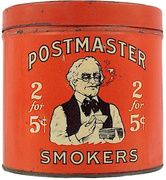 Cigar Memorabilia Is Still Smoking
Cigar Memorabilia Is Still Smoking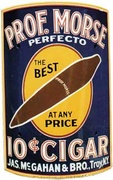
 Where There's Smoke There's a Vintage Cigarette Lighter
Where There's Smoke There's a Vintage Cigarette Lighter Cigar Memorabilia Is Still Smoking
Cigar Memorabilia Is Still Smoking The Disappearing Art of Porcelain Signs
The Disappearing Art of Porcelain Signs Cigar and Cigarette LightersFirst invented in 1823 and improved in the 1880s, pocket cigarette lighters…
Cigar and Cigarette LightersFirst invented in 1823 and improved in the 1880s, pocket cigarette lighters… Zippo LightersThe Zippo Manufacturing Company was founded by George Blaisdell in Bradford…
Zippo LightersThe Zippo Manufacturing Company was founded by George Blaisdell in Bradford… TobaccianaTobacco became popular in Europe in the 1600's, after traders brought back …
TobaccianaTobacco became popular in Europe in the 1600's, after traders brought back …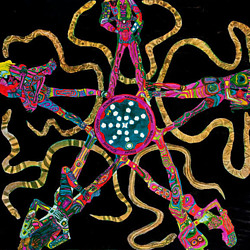 Mari Tepper: Laying it on the Line
Mari Tepper: Laying it on the Line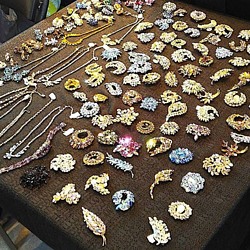 Nice Ice: Valerie Hammond on the Genteel Charm of Vintage Canadian Costume Jewelry
Nice Ice: Valerie Hammond on the Genteel Charm of Vintage Canadian Costume Jewelry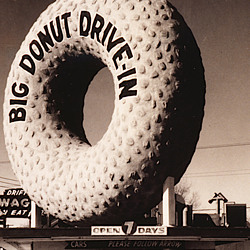 How Jim Heimann Got Crazy for California Architecture
How Jim Heimann Got Crazy for California Architecture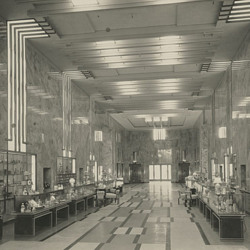 Modernist Man: Jock Peters May Be the Most Influential Architect You've Never Heard Of
Modernist Man: Jock Peters May Be the Most Influential Architect You've Never Heard Of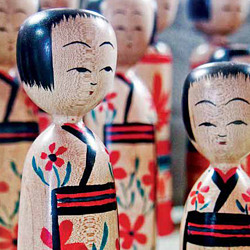 Meet Cute: Were Kokeshi Dolls the Models for Hello Kitty, Pokemon, and Be@rbrick?
Meet Cute: Were Kokeshi Dolls the Models for Hello Kitty, Pokemon, and Be@rbrick?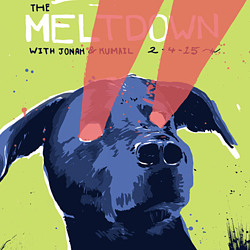 When the King of Comedy Posters Set His Surreal Sights on the World of Rock 'n' Roll
When the King of Comedy Posters Set His Surreal Sights on the World of Rock 'n' Roll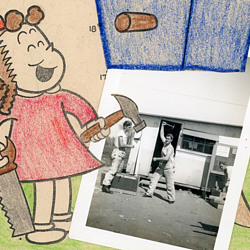 How One Artist Makes New Art From Old Coloring Books and Found Photos
How One Artist Makes New Art From Old Coloring Books and Found Photos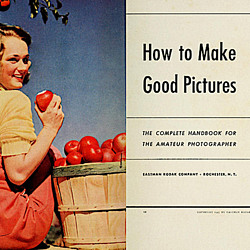 Say Cheese! How Bad Photography Has Changed Our Definition of Good Pictures
Say Cheese! How Bad Photography Has Changed Our Definition of Good Pictures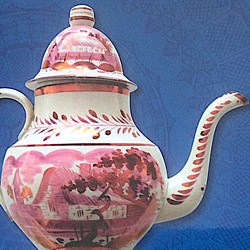 Middle Earthenware: One Family's Quest to Reclaim Its Place in British Pottery History
Middle Earthenware: One Family's Quest to Reclaim Its Place in British Pottery History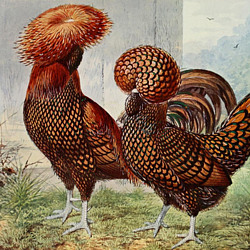 Fancy Fowl: How an Evil Sea Captain and a Beloved Queen Made the World Crave KFC
Fancy Fowl: How an Evil Sea Captain and a Beloved Queen Made the World Crave KFC
I have an old Bakelite cube shaped lighter that has playing card suites on each side.
The main lighter mechanism is inserted into the cube.
Because the body is black – the spades and clubs are coloured gold.
I would like to hear from anyone that can possibly let me know how old this is.
I have painstakingly restored the lighter to working condition – lighter fluid and flint spring action workings.
What a fantastic lighter….. can’t wait to get a response.
Thank you all…. Ross
I have a lighter that says signal umfg can you identify
WHEN DID SCRIPTO STOP MAKING THE VU-LIGHTER
I got this lighter from my sister, who found it at a Chinese garage sale. I think it’s circa 1970. Apple shape .. fill reservoir sponge with fluid and pull the stem out to ignite it. Has batteries . Where can I post a pic?
Anyone know it’s worth?
I’m looking for history on Supreme lighters made in Japan. Is there away to date a Supreme by bottom markings?
I have over 100 zippos and have never smoked. I only buy bargains and can’t believe they all cost about 30$ at any smoke shop. Idk what it is that has attracted me to them…small, firm, the click, and some awesome tricks I’ve always wanted to learn.
I have a No19528 Penguin lighter. Missing a screw
I have 6 oval gold colored cigarette lighters that were supposed to be given as favors from the Kaufmann family in Sewickley, PA do not have any timeline when this was done. I am not able to find any info on these lighters. Do you know of such type of lighter? I do not think they are worth that much. Just would like some info. Thank you Martha Young
I have a Braun Dymatic Cigarette Lighter Made in West Germany about 1975 that will not hold the butane gas is there anyone you can refer me to that can repair this. ? Please help!!!
Wanted to know if a lighter made in Japan that is supposed to be used as a vehicle looking like it would be used in fighting. Long canon, four large wheels and a tiny piece you push down and the middle pops open the flame.
I have a red and black enamel gas roller lighter with SONNILITE on the bottom and i cant find a thing out about it could u help me please find out some info cause its such a nice lighter for there 2 be no info 2 find online about it thank u phill
I have a lighter that I found in my grandpas WW2 stuff and I cannot find anything on the light the companies name was Knight out of Austria and its engraved USA patent pending
I have a lighter, looks like a pocket watch with Patent 22187 of 1899 on one side. It was patented November 6 1899 US657728A There’s a drawing of it on the Internet if you look up Patent 22187.
Inventors were Leopold Ernest Butcher of London and Marshall George Wood of Brighton England
Is it worth anything? Would love to know. Thank you. Rosie
I have my uncle’s BROT lighter from 1953 korea when he was in the war…but i can find out nothing about BROT….know anything?
Thanks. Means a lot to me.
I have cigarette lighter that I dont know how old but it looks like two people dancing and they have hats on and the hats raise up to teh lighter area
i have a penguin lighter made in japan with “rudy vallee”engraved on it. Is this rare or of any value? Thank you
I just found a lighter from Austria, it says Bedford on the side. I haven’t been able to pull the bottom part off yet and it’s missing a small screw on the bottom. From pictures I have found, it looks like a squeeze lighter, from the 1940’s. Almost like one on the second picture on this page. I would love to know more about it and possibly information about getting it in working order and cleaning it up. But it may use naptha. Any information is appreciated. Thank you.
I have a lighter that has x brands imprinted on the bottom. Also has Japan on the bottom. Has Nancy’s Truck Stop Snead AlA inscribed on the side. I remember this truck stop being there in the 60’s. Just wondering. Looks like a Zippo but does not have that anywhere. Would just like some info. It belonged to my husband. Love finding small memoriable.
Hi. A few years back I belonged to a couple Lighter Clubs – but due to family illness and the Pandemac, I fell out of ciculation. It appears the clubs have terminated. I have approx 3500 lighters and am interested in locating an active Lighter Club….Do you have any contact info for any Club (s)?
I would appreciate any help you could offer.
Thanks,
Jim
I have a silver metal lighter that has the name New Forte on it but cant seem to find any info on it why not is it real or foreighn of some kind
I have a very small and thin lighter it has a marking on it and it says Brass no.9 I and many people that I know did some research and came up with nothing while doing I was told people and I history teacher that the number brass number 9 lighters they are only 5 made in the word . I need help finding out more about this lighter .
I have a ceramic, I think, square table lighter that has vines on all four sides and has the word Kitzbuhul on the corner. On the part with the flame it only says gas. All I know is its maybe from Austria. Can you please tell me anything about this.
Marboro No. 6 lighter vintage gold plated possibly with leather case both case and lighter have a sticker on them that says Korea
I have a Rowenta Petite ladies flint lighter complet with original box and a cleaning brush.The colour is a red ceramic with oriental look of a love bird on a branch.Purchased 1964 in Germany.Stamped no6 or9.
i have a world war trench lighter that needs a new wick, the chimney of the lighter is too narrow to let me replace , have you any suggestions, maybe file out the chimney ??? kind regrds